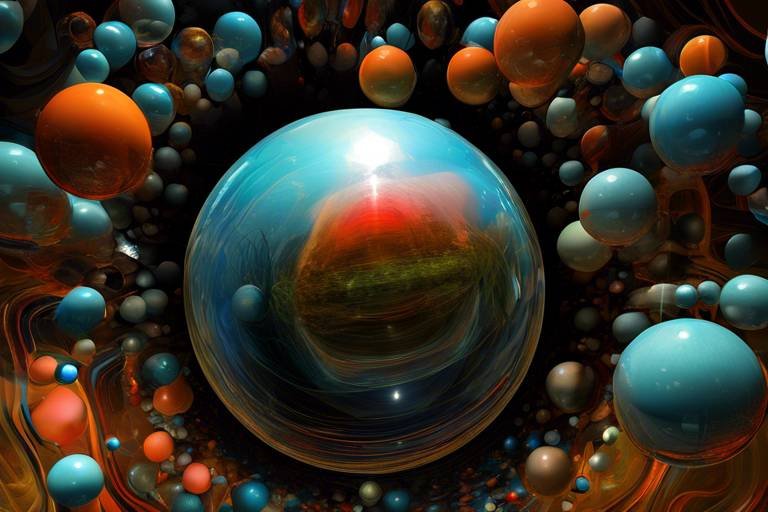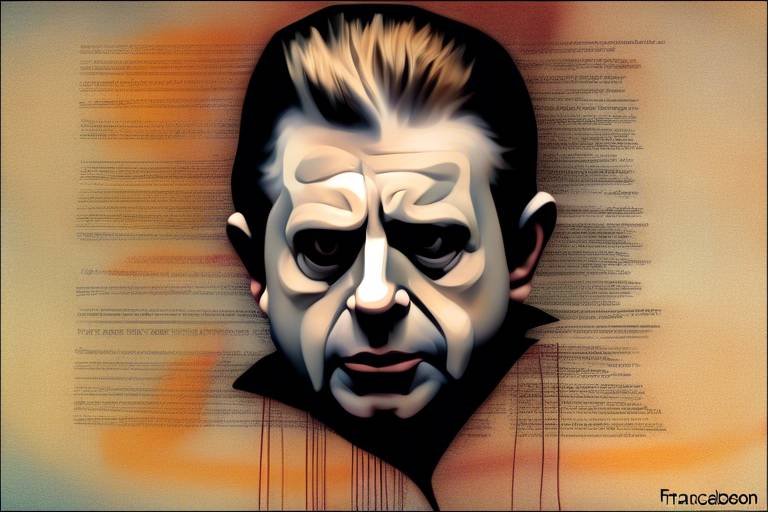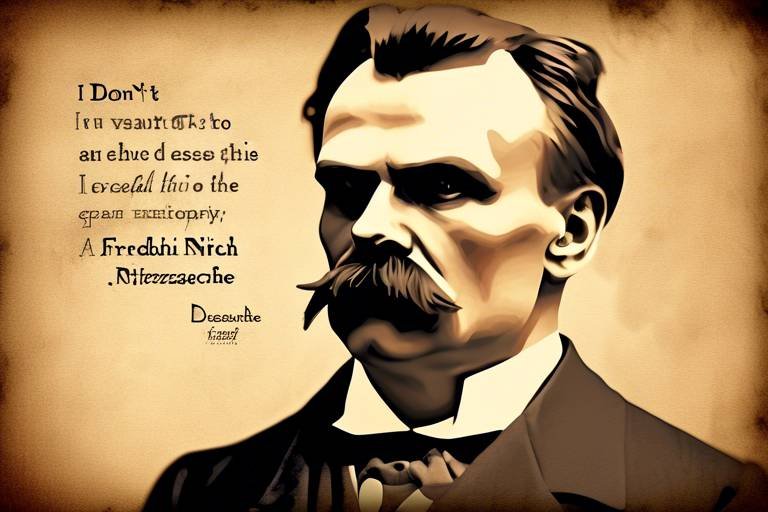Peter Sloterdijk’s Philosophical Exploration of Spheres
In a world where our interactions are increasingly mediated by technology and social constructs, the philosophical insights of Peter Sloterdijk offer a refreshing lens through which to examine our existence. Sloterdijk’s exploration of spheres provides a unique framework to understand the spaces we inhabit—both physically and metaphorically. His work invites us to consider how these spheres shape our identities, relationships, and experiences. Imagine walking into a cozy room filled with warmth and laughter; that’s the essence of what Sloterdijk refers to as the "bubble," a personal sphere that embodies intimacy and comfort. But as we expand our view, we encounter larger constructs—the "globes" of our social and cultural environments—where collective identities form and evolve. Finally, the "foam" represents the intricate web of modern life, where multiple spheres intersect, creating a rich tapestry of human experience. This article delves deep into these concepts, revealing how Sloterdijk's ideas resonate with our contemporary struggles and aspirations.
At the heart of Sloterdijk's philosophy is the idea that our existence is fundamentally shaped by the spheres we inhabit. These spheres are not just physical spaces; they are metaphysical environments that embody our relationships and experiences. Think of them as the bubbles of existence that surround us, influencing our perceptions and interactions. Each sphere represents a different layer of human experience, from the intimate to the collective, and they all contribute to our understanding of what it means to be human. Sloterdijk argues that these spheres are essential for fostering social bonds, as they create the conditions necessary for interaction and connection. For instance, the bubble of family and close friends provides the emotional support we need, while the globe of our community offers a sense of belonging and shared identity. As we navigate through these spheres, we begin to see how our lives are intricately woven into a larger tapestry of human existence.
The first sphere, known as the bubble, is all about intimacy and safety. This sphere represents the personal spaces where we feel most at home—be it in the embrace of a loved one or the comfort of our favorite chair. It's in these bubbles that our most cherished relationships thrive, providing us with the emotional sustenance we need to navigate the world. Sloterdijk suggests that these intimate spheres are foundational to human existence; they are where we learn to love, trust, and connect with others. Imagine a child playing in a backyard, surrounded by family and friends; this bubble nurtures their development and shapes their understanding of relationships. However, as we grow, we also realize that these bubbles can be fragile, easily disrupted by external forces. The challenge lies in maintaining these intimate spaces while also engaging with the broader spheres that surround us.
Moving beyond the personal, we encounter the second sphere: the globes. These larger constructs represent the social and cultural contexts that shape our identities. Think of globes as the communities we belong to—our cities, nations, and even the global society we are part of. They encompass shared values, beliefs, and experiences that bind us together as a collective. Sloterdijk emphasizes the importance of these globes in fostering a sense of belonging and identity. For instance, consider how national holidays bring people together, creating a shared sense of purpose and celebration. However, in our increasingly globalized world, these globes can also lead to tensions and conflicts, as differing identities clash. The challenge we face is to navigate these complex social landscapes while remaining true to our individual selves.
The third sphere, known as foam, captures the chaotic and dynamic nature of modern life. In this metaphor, foam represents the coexistence of multiple bubbles and globes, highlighting the intricate interplay between individual and collective experiences. Imagine a bustling city where people from various backgrounds and cultures converge, each bringing their own unique bubbles into the mix. This foam creates a vibrant, albeit sometimes overwhelming, tapestry of human existence. Sloterdijk suggests that understanding this complexity is crucial for navigating our contemporary world. As we move through the foam of life, we must learn to appreciate the diversity of experiences and perspectives that surround us while also finding ways to connect with others amidst the chaos.
Sloterdijk’s exploration of spheres raises profound questions about existence, identity, and the nature of human relationships. As we delve into these concepts, we are prompted to consider: What does it mean to belong to a sphere? How do our spheres influence our perceptions of self and others? In an increasingly fragmented world, these questions become even more pertinent. The spheres we inhabit shape our experiences and interactions, and understanding their implications can lead us to deeper insights into our shared humanity. Sloterdijk’s work encourages us to reflect on the spaces we create and occupy, urging us to cultivate spheres that foster connection, understanding, and empathy.
While Sloterdijk's theories have garnered significant attention, they have not been without criticism. Some scholars argue that his concepts may oversimplify the complexities of social dynamics in contemporary society. For instance, the idea of neatly defined spheres might overlook the fluidity and overlap that characterize modern relationships. Additionally, critics question the applicability of his theories across different cultural contexts, suggesting that not all societies experience spheres in the same way. Despite these critiques, Sloterdijk's work remains influential, prompting ongoing discussions and debates about the nature of human existence.
Sloterdijk's ideas have found resonance in various fields, including sociology, architecture, and environmental studies. His exploration of spatial dynamics has inspired new approaches to understanding how our environments shape human interactions. For instance, architects may draw on Sloterdijk’s concepts to create spaces that foster community and connection, while sociologists might examine how different spheres influence social behavior. As we continue to grapple with the challenges of modern life, Sloterdijk's insights provide valuable frameworks for exploring the interplay between space and human relations.
Sloterdijk's work has significantly impacted modern philosophical discourse, inspiring new approaches to understanding existentialism, phenomenology, and postmodern thought. His unique perspective on spheres encourages a reevaluation of traditional philosophical concepts, urging thinkers to consider the spatial dimensions of human existence. As philosophers grapple with the complexities of contemporary life, Sloterdijk's ideas offer fresh insights and avenues for exploration.
As philosophical inquiry evolves, Sloterdijk's sphere theory invites ongoing exploration into the implications of space and human relations in a rapidly changing world. The challenges we face today—social fragmentation, environmental crises, and technological advancements—call for a deeper understanding of the spheres we inhabit. Sloterdijk’s work encourages us to reflect on how we can create more inclusive and supportive environments that foster connection and understanding. The future of sphere theory lies in its ability to adapt and respond to the evolving landscape of human existence, offering valuable insights for generations to come.
- What are Peter Sloterdijk's main ideas about spheres? Sloterdijk's main ideas revolve around the concept of spheres as metaphysical spaces that shape human relationships and experiences.
- How do the different spheres affect our lives? Each sphere, whether it be the bubble, globe, or foam, influences our interactions, sense of identity, and overall understanding of existence.
- What critiques exist regarding Sloterdijk's theories? Critics argue that his theories may oversimplify complex social dynamics and question their applicability across different cultural contexts.
- In what fields are Sloterdijk's ideas applied? His ideas have been applied in sociology, architecture, and environmental studies, among others, to explore spatial dynamics and human interactions.

The Concept of Spheres
Peter Sloterdijk's notion of spheres is not merely a philosophical abstraction; it’s a profound exploration of how we, as humans, navigate through our existence. Imagine for a moment that our lives are like balloons, each representing a unique sphere of influence and experience. These spheres encapsulate our relationships, emotions, and social interactions, creating a rich tapestry of human existence. Sloterdijk proposes that these metaphysical spaces are essential in shaping our understanding of the world around us.
At its core, the concept of spheres suggests that our experiences are not isolated but are interconnected through various layers of social and personal environments. Sloterdijk categorizes these spheres into three distinct types: the bubble, the globe, and the foam. Each type serves a unique purpose in illustrating how we relate to ourselves and others.
To better understand this framework, consider the following breakdown of the spheres:
| Type of Sphere | Description | Significance |
|---|---|---|
| Bubble | Intimate spaces of comfort and security | Foundation of personal relationships |
| Globe | Larger social and cultural contexts | Collective identities and shared experiences |
| Foam | Complexity of modern life | Dynamic interplay of individual and collective experiences |
Each sphere represents a layer of our existence, influencing how we perceive ourselves and our connections with others. The bubble is akin to the cozy warmth of a hug, where love and trust flourish. It’s where we feel safe and nurtured, often formed by family and close friends. The globe, on the other hand, expands our horizons, bringing in the essence of community and culture. It’s like stepping into a vibrant festival where diverse experiences come together, creating a sense of belonging. Finally, the foam reflects the chaotic yet beautiful complexity of modern life, where numerous bubbles and globes interact, sometimes clashing, sometimes harmonizing.
Sloterdijk’s spheres compel us to question our existence and the spaces we inhabit. They challenge us to think about how our relationships are formed and how they evolve within these conceptual environments. Are we merely floating in our bubbles, or are we engaging with the larger globes around us? This exploration invites us to consider the significance of our interactions and the implications they have on our identity.
In essence, the concept of spheres serves as a lens through which we can analyze our social fabric. It encourages us to reflect on the environments we create and inhabit, both physically and metaphorically. As we delve deeper into Sloterdijk’s philosophy, we uncover layers of meaning that resonate with our daily lives, prompting us to engage more thoughtfully with the world around us.

Sphere One: The Bubble
In Peter Sloterdijk's philosophical framework, the first sphere he introduces is the bubble. This concept is not merely a physical representation; it's a profound metaphor for the intimate spaces we create around ourselves. Imagine, if you will, a delicate bubble that encapsulates our personal relationships, experiences, and emotions. Within this bubble, we find comfort, security, and a sense of belonging. It's the realm where our most cherished connections thrive, where we feel safe to express our true selves without the fear of external judgment.
The bubble is fundamentally about intimacy. It represents the foundational aspects of human existence—think of it as the nurturing womb of our social lives. Within this sphere, we engage in our most meaningful interactions, whether it's the warmth of a family gathering, the laughter shared with close friends, or the quiet moments spent with a loved one. These bubbles can vary in size and significance; some may be small and personal, like a cozy dinner for two, while others can expand to include a larger circle of friends and family.
However, the bubble is not just about comfort. It also poses intriguing questions about the nature of our relationships. For instance, how do we maintain the integrity of our bubbles in an increasingly chaotic world? Do we allow outside influences to penetrate our safe spaces, or do we strive to protect them fiercely? The bubble invites us to reflect on the delicate balance between openness and boundaries in our interpersonal connections.
Moreover, Sloterdijk emphasizes that these bubbles are not isolated entities. They are interconnected, often overlapping with one another. Just like bubbles in a soap dish, they can merge and create new forms of social interaction. This interplay between bubbles can lead to rich, layered experiences—an intimate dinner party that becomes a lively discussion among friends, for example. It's a beautiful reminder that our personal spheres are not only about individual comfort but also about the collective dynamics that emerge when we come together.
In this sense, the bubble acts as a microcosm of our social world. It highlights the importance of nurturing our close relationships while also recognizing the impact of our social environments. As we navigate through life, understanding the concept of the bubble can help us appreciate the significance of our personal connections and the spaces we create for ourselves and others.

Sphere Two: The Globes
When we shift our focus from the intimate confines of the bubble to the expansive realms of the globe, we enter a world where collective identities and shared experiences reign supreme. Sloterdijk's concept of the globe encapsulates the idea that human existence is not merely a solitary journey but a social tapestry woven from the threads of countless interactions and cultural influences. Imagine a vibrant marketplace, where individuals from diverse backgrounds come together, each bringing their own stories, beliefs, and traditions. This is the essence of the globe—an environment that fosters a sense of belonging and community.
The globe signifies the larger social and cultural contexts that shape our understanding of ourselves and our place in the world. Within this sphere, we navigate through various social structures, be it family, community, or nation. These structures serve as frameworks that influence our behaviors, values, and perceptions. As we engage in these collective spaces, we begin to form shared narratives that define our identities and forge connections with others.
In essence, the globe is a reflection of the intricate web of relationships that bind us. It raises important questions about how we relate to one another and what it means to belong. Are we merely products of our environments, or do we actively shape them? The answer lies in the dynamic interplay between the individual and the collective. Just as a globe is not a static object but a constantly rotating sphere, our identities are continually evolving as we interact with others.
Consider how cultural events, such as festivals or communal gatherings, exemplify the concept of the globe. These occasions allow individuals to come together, share their experiences, and celebrate their collective identity. They serve as reminders that we are part of something greater than ourselves, a community that thrives on diversity and unity. In this sense, the globe is not just a physical space; it is a metaphysical realm where human experiences converge, creating a rich tapestry of life.
Moreover, Sloterdijk's globes can be seen in various societal constructs, such as nations, religions, and even social media platforms. Each of these constructs provides a unique space for individuals to explore their identities while simultaneously contributing to the larger narrative of the globe. For instance, social media has transformed the way we connect, allowing us to forge relationships across geographical boundaries and cultural divides. This digital globe has created a new form of community, where ideas and experiences can be shared instantaneously, reshaping our understanding of belonging in the modern world.
As we delve deeper into the implications of the globe, we must also acknowledge the challenges it presents. The coexistence of multiple globes can lead to tensions, misunderstandings, and conflicts. For example, differing cultural values may clash, leading to a struggle for recognition and acceptance. This highlights the importance of fostering open dialogue and empathy among individuals from diverse backgrounds, ensuring that the globe remains a space of inclusivity rather than division.
In summary, the globe represents a vital aspect of Sloterdijk's sphere theory, emphasizing the significance of collective identities and shared experiences in shaping our understanding of community and belonging. As we navigate through our lives, we must remain aware of the intricate connections that bind us, recognizing that our existence is deeply intertwined with the lives of others. Embracing the complexities of the globe can lead to a richer, more fulfilling understanding of what it means to be human in an increasingly interconnected world.
- What are the main characteristics of the globe in Sloterdijk's theory?
The globe represents larger social and cultural contexts, emphasizing collective identities, shared experiences, and the dynamic interplay between individual and community. - How does the concept of the globe relate to modern society?
The globe reflects the interconnectedness of individuals through social structures, cultural events, and digital platforms, shaping our understanding of belonging and identity. - What challenges arise from the coexistence of multiple globes?
Conflicts may occur due to differing cultural values, highlighting the need for empathy and open dialogue among diverse groups.

Sphere Three: The Foam
When we dive into the third sphere, known as the foam, we encounter a captivating metaphor that captures the chaotic and intricate nature of modern existence. Imagine a bubbling cauldron of life, where countless bubbles—each representing individual experiences, identities, and relationships—float in a vast ocean of shared realities. This is the essence of foam: a complex intermingling of various spheres, where personal bubbles collide and interact, creating a rich tapestry of human experience.
In this dynamic environment, the boundaries between individual and collective become blurred. Just as foam is made up of numerous bubbles, our lives are intertwined with those of others, resulting in a vibrant but often tumultuous social landscape. This sphere challenges us to rethink our understanding of community and identity. Are we simply isolated bubbles, or are we part of a larger foam that shapes our existence? The foam invites us to explore the interdependencies that define our relationships and social structures.
One of the most striking features of foam is its fluidity. Unlike the rigid structure of a globe, which represents fixed identities and communities, foam is ever-changing. It reflects the realities of globalization, technological advancement, and cultural exchange, where people from different backgrounds and experiences come together, sometimes harmoniously and other times in conflict. This fluidity can be both exhilarating and overwhelming. We navigate through layers of social interactions, each bubble representing a unique perspective and story.
Moreover, foam highlights the diversity of human experiences. Just as no two bubbles are identical, our individual lives are marked by distinct narratives and challenges. The foam metaphor encourages us to embrace this diversity, recognizing that our differences can enrich our understanding of the world. In this sphere, we are reminded that every interaction—no matter how small—contributes to the larger social fabric, creating a complex interplay of ideas, emotions, and connections.
To further illustrate the concept of foam, we can visualize its characteristics in a simple table:
| Characteristic | Description |
|---|---|
| Fluidity | Constantly changing and adapting, reflecting modern life's complexities. |
| Diversity | Each bubble represents unique experiences and perspectives, contributing to a rich social tapestry. |
| Interconnectedness | Bubbles interact and influence one another, highlighting the importance of relationships. |
| Chaos | While beautiful, the foam can also be overwhelming, reflecting the challenges of modern existence. |
In conclusion, the foam sphere serves as a profound reminder of the complexity of our lives. It asks us to consider how we navigate our personal bubbles while engaging with the larger foam of society. Are we aware of the connections we forge, the impacts we have on others, and the collective narrative we create? By recognizing the beauty and chaos of foam, we can better appreciate the intricate web of existence that binds us all together.
- What does the foam represent in Sloterdijk's philosophy?
Foam symbolizes the complexity and interconnectedness of modern human experiences, where individual identities coexist and interact within a larger social context. - How does foam differ from bubbles and globes?
Bubbles represent intimate personal spaces, while globes signify larger social contexts. Foam encompasses both, illustrating the dynamic interplay between individual and collective experiences. - Why is the concept of foam important in today's society?
Foam highlights the fluidity and diversity of human relationships in a rapidly changing world, encouraging us to embrace our interconnectedness and the richness it brings to our lives.

Philosophical Implications
Peter Sloterdijk's exploration of spheres is not just an abstract exercise in philosophy; it opens the door to a myriad of profound questions about our existence and the nature of human relationships. By conceptualizing spheres as metaphysical spaces, Sloterdijk challenges us to rethink how we perceive our connections with others and the environments we inhabit. It’s like looking through a kaleidoscope, where each turn reveals a new pattern of interaction and identity.
At the core of Sloterdijk's theory is the idea that our social relations are deeply embedded within these spheres. The bubble, globe, and foam serve as metaphors for our personal and collective experiences, prompting us to consider how these spaces shape our identities. For instance, think about your own life: how do your intimate relationships (the bubbles) influence your sense of belonging in broader communities (the globes)? This interplay raises questions about the nature of belonging and how it evolves in a world increasingly marked by fragmentation and disconnection.
Moreover, Sloterdijk's framework urges us to reflect on the existential dimensions of our existence. In a fast-paced, ever-changing society, how do we maintain our sense of self amid the chaos of overlapping spheres? The foam, representing the complexity of modern life, suggests that our identities are not fixed but are constantly being reshaped by our interactions with various bubbles and globes. This dynamic nature of identity invites a deeper inquiry into what it means to be human in a world where traditional boundaries are dissolving.
In addition, Sloterdijk’s theory provokes thought about the ethical implications of our relationships within these spheres. As we navigate through different social contexts, what responsibilities do we hold towards others? How do our actions within one sphere affect those in another? These questions resonate with contemporary issues such as globalization, social justice, and environmental sustainability. For instance, the way we treat our immediate environment (our bubble) can have far-reaching consequences on global ecological systems (the globe).
Ultimately, Sloterdijk’s philosophical implications extend beyond mere theory; they invite us to engage with our world in a more conscious and intentional manner. As we ponder these ideas, we may find ourselves asking: How can we create spheres that foster genuine connection and understanding? The answers may not be straightforward, but the journey of exploration is where the real philosophical richness lies.
- What are the three types of spheres described by Sloterdijk?
Sloterdijk describes three types of spheres: the bubble, the globe, and the foam, each representing different aspects of human existence and social relations. - How does Sloterdijk's theory relate to contemporary issues?
His theory prompts discussions about identity, belonging, and our ethical responsibilities in a fragmented world, addressing issues like globalization and environmental concerns. - Why is the concept of spheres significant in philosophy?
The concept encourages a deeper understanding of how our spaces shape our interactions and identities, challenging traditional notions of individualism and community.

Critiques of Sloterdijk's Theory
While Peter Sloterdijk's exploration of spheres has garnered significant attention and admiration, it is not without its critics. Many philosophers and social theorists have raised concerns about the applicability of his ideas, suggesting that they may oversimplify the complex dynamics of modern society. One of the primary critiques is that Sloterdijk's framework, while innovative, risks reducing the intricate tapestry of human relationships to mere categories. Critics argue that this can lead to a detached understanding of social interactions, where the richness of individual experiences is overshadowed by broad classifications.
Moreover, some scholars point out that Sloterdijk's focus on spheres may inadvertently promote a sense of isolation. By emphasizing the boundaries between different spheres—such as bubbles, globes, and foam—there's a danger of implying that individuals exist in silos, disconnected from one another. This perspective can be particularly problematic in a world that increasingly values interconnectedness and collaboration. The notion of separate spheres might downplay the importance of shared experiences and collective struggles that define contemporary life.
Another critique revolves around the potential for elitism within Sloterdijk's theory. Critics argue that his philosophical approach may inadvertently privilege certain social groups or perspectives, creating a hierarchy of experiences. For instance, the concept of the bubble may resonate more with individuals from privileged backgrounds who can afford to create personal sanctuaries, while those from less fortunate circumstances may find themselves excluded from this discourse. This raises questions about inclusivity and representation in philosophical discussions.
Furthermore, the application of Sloterdijk's spheres in real-world contexts has been met with skepticism. Some scholars have questioned whether his ideas can effectively address the nuances of social dynamics in various cultural settings. For instance, can the concept of foam truly encapsulate the chaotic and often unpredictable nature of social interactions in urban environments? Critics argue that while the theory offers a compelling lens for analysis, it may fall short in providing practical solutions or insights into the lived experiences of individuals.
In light of these critiques, it is essential to approach Sloterdijk's theories with a critical eye. While his work undoubtedly contributes to philosophical discourse, acknowledging its limitations can pave the way for more nuanced discussions about the nature of human relationships in a complex and ever-changing world. Engaging with these critiques not only enriches our understanding of Sloterdijk's ideas but also encourages a broader examination of how we conceptualize space and community in our lives.
- What are the main critiques of Sloterdijk's sphere theory?
Critics argue that his framework may oversimplify complex social dynamics, promote isolation, and risk elitism by favoring certain perspectives over others. - How does Sloterdijk's theory relate to modern social interactions?
While it offers an interesting lens for analysis, some believe it may not adequately address the nuances of contemporary social dynamics. - Can Sloterdijk's spheres be applied in practical settings?
There is skepticism regarding the applicability of his theories in real-world contexts, particularly in urban environments where social interactions are often chaotic.

Applications in Contemporary Thought
Peter Sloterdijk's exploration of spheres has transcended traditional philosophical boundaries and found fertile ground in various contemporary fields. From sociology to architecture, his ideas have sparked discussions that challenge our understanding of space and human interaction. But how exactly do these spheres manifest in our modern world? Let's dive deeper!
In sociology, Sloterdijk's concepts are often used to analyze the dynamics of social groups and communities. The idea of bubbles can be seen in tight-knit communities where personal relationships thrive, while the globes reflect broader societal norms and cultural identities. This duality helps sociologists understand how individuals navigate their personal spaces while being influenced by larger social constructs. For instance, consider how social media has created virtual bubbles that both connect and isolate individuals, shaping their identities in profound ways.
Architecture, too, has been influenced by Sloterdijk's theories. Designers and architects are increasingly aware of how physical spaces can foster or hinder social interactions. The notion of foam—a complex layering of bubbles and globes—can be applied to urban planning, where cities are designed not just for functionality but for enhancing social ties. For example, public spaces that encourage gatherings and interactions can be seen as an architectural embodiment of Sloterdijk's spheres, promoting a sense of community amidst the chaos of modern life.
Moreover, in environmental studies, Sloterdijk's ideas prompt a rethinking of our relationship with nature. The concept of spheres encourages a holistic view of our environment, emphasizing the interconnectedness of human and ecological systems. This perspective is crucial as we face pressing global challenges like climate change. By viewing our planet as a shared sphere, we can foster a sense of responsibility and stewardship that transcends individualistic tendencies.
To illustrate the diverse applications of Sloterdijk's theories, consider the following table that outlines how different fields have embraced his concepts:
| Field | Application |
|---|---|
| Sociology | Analyzes social dynamics through the lens of bubbles and globes, exploring community and identity. |
| Architecture | Designs spaces that encourage social interaction, reflecting the foam-like complexity of urban life. |
| Environmental Studies | Promotes a holistic view of human and ecological systems, emphasizing interconnectedness and responsibility. |
In summary, Sloterdijk's sphere theory is not just an abstract philosophical concept but a practical framework that resonates across various disciplines. It encourages us to rethink how we relate to each other and our environment, offering profound insights into the complexities of modern existence. As we continue to explore these applications, we can better understand the intricate web of human relations and the spaces we inhabit.
- What are the three spheres defined by Sloterdijk? Sloterdijk's three spheres are the bubble (intimate spaces), the globe (larger social contexts), and foam (the complexity of overlapping bubbles and globes).
- How can Sloterdijk's theories be applied in everyday life? His theories can help individuals understand their personal relationships and social dynamics, guiding how they navigate their communities and environments.
- Why is the concept of spheres important in contemporary thought? It provides a framework for understanding the interconnectedness of human experiences, social relationships, and environmental issues in a rapidly changing world.

Influence on Modern Philosophy
Peter Sloterdijk’s exploration of spheres has left a significant mark on the landscape of modern philosophy. His innovative approach invites us to reconsider how we perceive space and human relationships. By framing existence within the context of spheres, Sloterdijk challenges traditional philosophical boundaries, urging us to think beyond the individual and consider the larger frameworks that shape our lives. This perspective is akin to viewing life through a series of lenses, each revealing different dimensions of our existence.
One of the most compelling aspects of Sloterdijk’s work is its ability to resonate across various philosophical domains. For instance, his ideas touch upon existentialism, where the focus on individual experience is expanded to include the collective. In this way, he aligns with thinkers like Jean-Paul Sartre and Martin Heidegger, yet he diverges by emphasizing the spatial dimensions of existence. Rather than seeing individuals as isolated entities, Sloterdijk illustrates how our identities are constructed within the context of spheres that encompass us.
Moreover, Sloterdijk’s theories have sparked discussions in phenomenology, particularly in how we experience our surroundings. He posits that our interactions with these spheres shape our perceptions and, consequently, our reality. This idea can be likened to the notion of environmental perception in phenomenology, where the environment is not merely a backdrop but an active participant in our lived experiences. This framework encourages a more nuanced understanding of human existence and the interconnectedness of our experiences.
In addition to existentialism and phenomenology, Sloterdijk’s work has influenced postmodern thought. His emphasis on the fluidity of identity within the context of spheres resonates with postmodern critiques of fixed narratives and stable identities. By suggesting that our identities are shaped by the bubbles, globes, and foams we inhabit, he aligns with thinkers like Michel Foucault and Jacques Derrida, who challenge the notion of a singular, coherent self.
Furthermore, the implications of Sloterdijk’s sphere theory extend into practical realms, influencing contemporary debates in sociology, architecture, and even environmental studies. His ideas encourage a rethinking of how we design spaces that foster community and connection, prompting architects and urban planners to consider the social dynamics that emerge from spatial arrangements. This intersection of philosophy and practical application exemplifies the relevance of Sloterdijk’s work in addressing modern societal challenges.
In summary, Peter Sloterdijk’s influence on modern philosophy is profound and multifaceted. By redefining our understanding of spheres, he opens up new avenues for exploring the complexities of existence, identity, and human relationships. His work not only enriches philosophical discourse but also provides valuable insights into the ways we can navigate the challenges of contemporary life.
- What are the main spheres in Sloterdijk's theory? Sloterdijk identifies three main spheres: the bubble, the globe, and the foam, each representing different levels of human interaction and existence.
- How does Sloterdijk's work relate to existentialism? His theories expand on existentialist ideas by emphasizing the importance of collective experiences and the spatial context of identity.
- Can Sloterdijk's theories be applied in practical fields? Yes, his ideas have influenced various fields, including sociology, architecture, and environmental studies, prompting new discussions on the dynamics of space and human interactions.

Future Directions in Sphere Theory
As we look towards the future, the implications of Peter Sloterdijk's sphere theory continue to evolve, prompting new inquiries into how we understand space and human relations. In a world that is rapidly transforming due to technology and globalization, the relevance of spheres becomes even more pronounced. Sloterdijk’s framework encourages us to consider how our intimate bubbles, expansive globes, and complex foams interact in an increasingly interconnected yet fragmented society.
One of the most intriguing directions for future research lies in the intersection of sphere theory with digital spaces. As our lives become more intertwined with technology, we find ourselves creating virtual bubbles that can either enhance or diminish our sense of community. The digital landscape is a new sphere where personal interactions take place, often leading to questions about authenticity and connection. How do these online interactions shape our real-world relationships? Are we, in essence, creating new forms of globes in cyberspace?
Moreover, the environmental implications of sphere theory cannot be overlooked. As we grapple with issues like climate change and urbanization, understanding how our physical spaces (the foams we inhabit) affect our collective existence becomes crucial. Sloterdijk's ideas can inspire innovative approaches to sustainable living, encouraging us to consider how our bubbles and globes impact the planet. The challenge lies in reconciling our personal comforts with our responsibilities to the environment.
Another promising avenue for exploration is the application of sphere theory in interdisciplinary studies. Fields such as sociology, psychology, and even architecture can benefit from a deeper understanding of how spheres function. For example, how do architectural designs influence our bubbles of comfort? Can urban planning create globes that foster community and collaboration? By integrating Sloterdijk's concepts into various disciplines, we can develop a more holistic understanding of human existence.
In summary, the future of sphere theory is rich with potential. As we navigate a world shaped by technology, environmental challenges, and complex social dynamics, Sloterdijk's framework offers a compelling lens through which to examine our interactions and the spaces we occupy. The ongoing dialogue surrounding spheres will undoubtedly inspire new philosophical inquiries and practical applications, ultimately enriching our understanding of what it means to exist together in this intricate web of life.
- What are the three types of spheres according to Sloterdijk?
The three types of spheres are the bubble (intimate spaces), the globe (larger social contexts), and foam (the complexity of modern life). - How can sphere theory be applied to contemporary issues?
Sphere theory can be applied to understand digital interactions, environmental challenges, and interdisciplinary studies. - What is the significance of spheres in understanding human relationships?
Spheres help us conceptualize the different layers of human interactions, from personal relationships to broader social constructs.
Frequently Asked Questions
- What are Peter Sloterdijk's spheres?
Peter Sloterdijk's spheres are philosophical concepts that represent different layers of human existence and relationships. They are categorized into three main types: the Bubble, which symbolizes intimate personal spaces; the Globes, representing larger social contexts; and Foam, illustrating the complex interplay of multiple bubbles and globes in modern life.
- How does the concept of the Bubble relate to human relationships?
The Bubble signifies the intimate spaces where personal relationships thrive. It emphasizes comfort, security, and the foundational aspects of human existence, much like a cozy blanket that wraps around you, providing warmth and safety in a chaotic world.
- What role do the Globes play in our understanding of community?
The Globes represent broader social and cultural contexts, highlighting collective identities and shared experiences. They help us understand how communities are formed and how individuals relate to one another within these larger frameworks, akin to a tapestry woven from many threads.
- Can you explain the Foam concept?
Foam illustrates the complexity of modern life, where various bubbles and globes coexist. It reflects the dynamic interplay between individual and collective experiences, similar to a bustling city where different lives and stories intersect and overlap.
- What are some critiques of Sloterdijk's theory?
While Sloterdijk's theories are influential, they have faced criticism for potentially oversimplifying complex social dynamics. Some argue that the spheres may not fully capture the nuances of human relationships in today's fragmented society.
- How have Sloterdijk's ideas influenced contemporary thought?
Sloterdijk's concepts have resonated across various fields, including sociology, architecture, and environmental studies. His ideas prompt discussions on spatial dynamics and human interactions, encouraging a reevaluation of how we perceive our environments.
- What impact has Sloterdijk had on modern philosophy?
Sloterdijk has significantly influenced modern philosophical discourse, inspiring new perspectives on existentialism, phenomenology, and postmodern thought. His work challenges traditional views and encourages deeper inquiry into the nature of existence.
- What are the future directions for sphere theory?
As philosophical inquiry continues to evolve, Sloterdijk's sphere theory invites ongoing exploration into the implications of space and human relations. It encourages us to think critically about how our environments shape our identities and interactions in an ever-changing world.



















